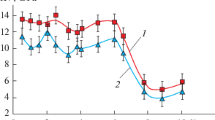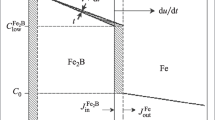Abstarct
—In this paper, we present data from studies of the iron boride synthesis upon induction heating to 1000°C for 5 min of samples of steel 20 coated with a charge containing Fe–H3BO3. The content of boric acid in the charge composition varied from 25 to 75 wt %. The charge in the experiments can be diluted with a solution of liquid glass in water with the addition of a small amount of ammonium hydroxide and coal. The microhardness study of the surface layer showed that a macroscopically extensive diffusion zone with a size of 900–1000 μm, in which the boride content gradually decreases when moving deeper into the matrix, is formed during the saturation of the surface layer of carbon steel 20 with boron. Such a size of the diffusion zone indicates an anomalously high mass transfer during boriding of steel 20. Indeed, the calculated diffusion coefficient during boriding under induction conditions (about 1.35 × 10–9 m2/s) is by two orders of magnitude higher than the diffusion coefficient in the classical version of boriding. X-ray studies showed that, under the considered conditions, Fe2B and FeB borides are synthesized, and a solid solution of boron in α-iron is also formed. An analysis of the phase composition of the structural components of the diffusion zone indicates that, from the surface to the matrix, the formation of boride phases occurs in the sequence of FeB → Fe2B → (α-phase + B) → base metal. The microstructure of the diffusion zone consists of more or less pronounced layers consisting of FeB and Fe2B boride phases. In general, especially deep-lying regions of the diffusion zone are a composite material consisting of a plastic α-phase and iron boride crystals. Crystals FeB and Fe2B in the layer are oriented mainly perpendicular to the diffusion front. This is due perhaps to the rapid predominant growth of the boride phase under conditions of high diffusion mobility of boron atoms in one direction and hindered in others.




Similar content being viewed by others
Notes
The boron distribution in the surface layer: http://metal-archive.ru/boridnye-pokrytiya/116-raspredelenie-bjra-v-poverhnostnim-sloe.html (Date of the application: Feb 9, 2022).
REFERENCES
Bakare, M.S., Voisey, K.T., Chokethawai, K., and McCartney, D.G., Corrosion behaviour of crystalline and amorphous forms of the glass forming alloy Fe43Cr16Mo16C15B10, J. Alloys Compd., 2012, vol. 527, pp. 210–218. https://doi.org/10.1016/j.jallcom.2012.02.127
Medvedovski, E., Advanced iron boride coatings to enhance corrosion resistance of steels in geothermal power generation, Adv. Appl. Ceram., 2020, vol. 119, no. 8, pp. 462–481. https://doi.org/10.1080/17436753.2020.1830359
Mebarek, B. and Keddam, M., A fuzzy neural network approach for modeling the growth kinetics of FeB and Fe2B layers during the boronizing process, Mater. Tech., 2018, vol. 106, no. 6, p. 603. https://doi.org/10.1051/mattech/2019002
Lakhtin, Yu.M. and Arzamasov, B.N., Khimiko-termicheskaya obrabotka metallov (Chemical and Thermal Treatment of Metals), Moscow: Metallurgiya, 1985.
Voroshnin, L.G. and Lyakhovich, L.S., Borirovanie stali (Steel Boriding), Moscow: Metallurgiya, 1978.
Voroshnin, L.G., Antikorrozionnye diffuzionnye pokrytiya (Anticorrosive Diffusion Coatings), Minsk: Naukaitekhnika, 1981.
Nora, R., Zine, T.M., Abdelkader, K., Youcef, K., Ali, O., and Jiang, X., Boriding and boronitrocarburising effects on hardness, wear and corrosion behavior of AISI 4130 steel, Materia, 2019, vol. 24, no. 1. https://doi.org/10.1590/s1517-707620190001.0609
Shevchuk, E.P., Plotnikov, V.A., and Akhmetzhanov, B.K., Study of boride layers of steel, Fundam. Probl. Sovrem. Materialoved., 2018, vol. 15, no. 3, pp. 386–391. https://doi.org/10.25712/ASTU.1811-1416.2018.03.012
Shevchuk, E.P., Plotnikov, V.A., and Bektasova, G.S., X-ray structural analysis of a diffusion boride layer on carbon steel, Izv. Altaiskogo Gos. Univ., 2018, no. 4, pp. 51–55. https://doi.org/10.14258/izvasu(2018)4-09
Shevchuk, E.P., Plotnikov, V.A., and Jes, A.V., Formation of an extensive diffusion zone during boration of steel 20, Fundam. Probl. Sovrem. Materialoved., 2018, vol. 15, no. 3, pp. 424–428. https://doi.org/10.25712/ASTU.1811-1416.2018.03.018
Mehrer, H., Diffusion in Solids: Fundamentals, Methods, Materials, Diffusion-Controlled Processes, Springer Series in Solid-State Sciences, vol. 155, Berlin: Springer, 2007. https://doi.org/10.1007/978-3-540-71488-0
Balgazin, I.I. and Sayapova, V.V., Finding the diffusion coefficient by the Monte Carlo method, Universum: Khim. Biol., 2018, no. 5. https://7universum.com/ru/ nature/archive/item/5801. Cited February 9, 2022.
Pavlov, P.V. and Khokhlov, A.F., Fizika tverdogo tela (Physics of Solids), Moscow: Vysshaya Shkola, 2000.
Gur’ev, A.M., Lygdenov, B.D., Gur’ev, M.A., Mei, Shunchi., and Vlasova, O.A., Boriding of low-carbon steel, Mezhdunarodnyi Zh. Eksp. Obraz., 2015, no. 12-4, pp. 572–273.
Bykova, T.M., Influence of steel chemical composition of on structure and properties of diffusion boride coatings, Cand. Sci. (Eng.) Dissertation, Yekaterinburg, 2016.
Krukovich, M.G., Prusakov, B.A., and Sizov, I.G., Plasticity of Boronized Layers, Berlin: Springer, 2016. https://doi.org/10.1007/978-3-319-40012-9
Epik A.P. Boride coatings, Boron and Refractory Borides, Berlin: Springer-Verlag, 1977, part 4, pp. 597–612.
Krukovich, M.G., Mechanism of diffusion layers formation, Novye Mater. Tekhnol. Mashinostr., 2012, no. 15, pp. 69–76.
Kouba, R., Keddam, M., and Kulka, M., Modelling of paste boriding process, Surf. Eng., 2015, vol. 31, no. 8, pp. 563–569. https://doi.org/10.1179/1743294414y.0000000357
Keddam, M., Ortiz-Dominquez, M., Elias-Espinosa, V., Damian-Mejia, O., Arenas-Flores, A., Gomez-Vargas, O.A., Abreu-Quijano, M., Aldana-Gonzalez, I.J., and Zuno-Silva, J., Growth kinetics of the Fe2B coating on AISIH13 steel, Trans. Ind. Inst. Met., 2015, vol. 68, no. 3, pp. 433–442. https://doi.org/10.1007/s12666-014-0472-x
Mebarek, B. and Keddam, M., Fuzzy logic approach for modelling the formation kinetics of Fe2B layer, Int. J. Comput. Mater. Sci. Surf. Eng., 2020, vol. 9, no. 2, pp. 147–156. https://doi.org/10.1504/IJCMSSE.2020.109563
Lygdenov, B.D., Intensification of formation of diffusion layer structure during chemical-thermal treatment of steels, Doctoral (Eng.) Dissertation, Barnaul, 2009.
Ekimov, E.A., Zibrov, I.P., and Zoteev, A.V., Preparation of boron microcrystals via high-pressure, high-temperature pyrolysis of decaborane, B10H14, Inorg. Mater., 2011, vol. 47, no. 11, pp. 1194–1198. https://doi.org/10.1134/S0020168511110069
Author information
Authors and Affiliations
Corresponding authors
Ethics declarations
The authors declare that they have no conflicts of interest.
Additional information
Translated by A. Ivanov
About this article
Cite this article
Shevchuk, E.P., Plotnikov, V.A. & Makarov, S.V. Features of Formation of a Diffusion Zone on Steel 20 Obtained by Boriding in an Induction Furnace. Steel Transl. 52, 145–150 (2022). https://doi.org/10.3103/S096709122202022X
Received:
Revised:
Accepted:
Published:
Issue Date:
DOI: https://doi.org/10.3103/S096709122202022X




